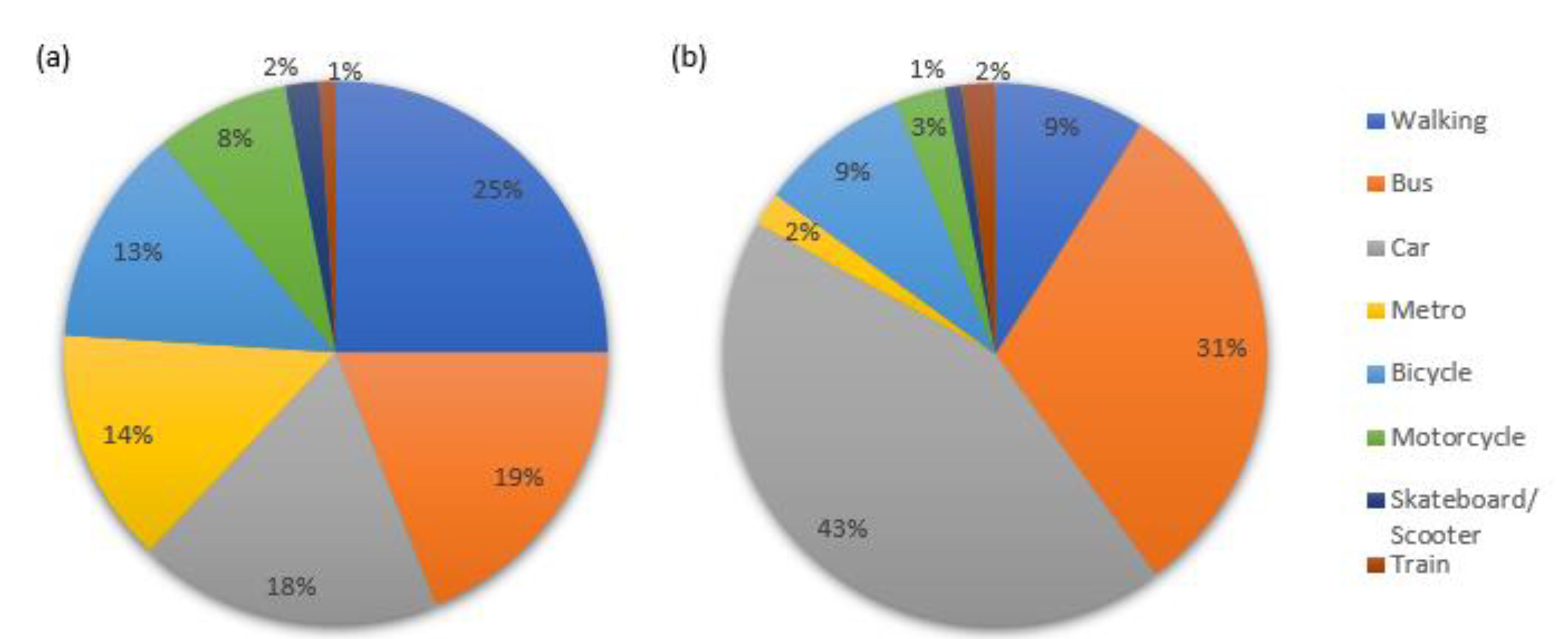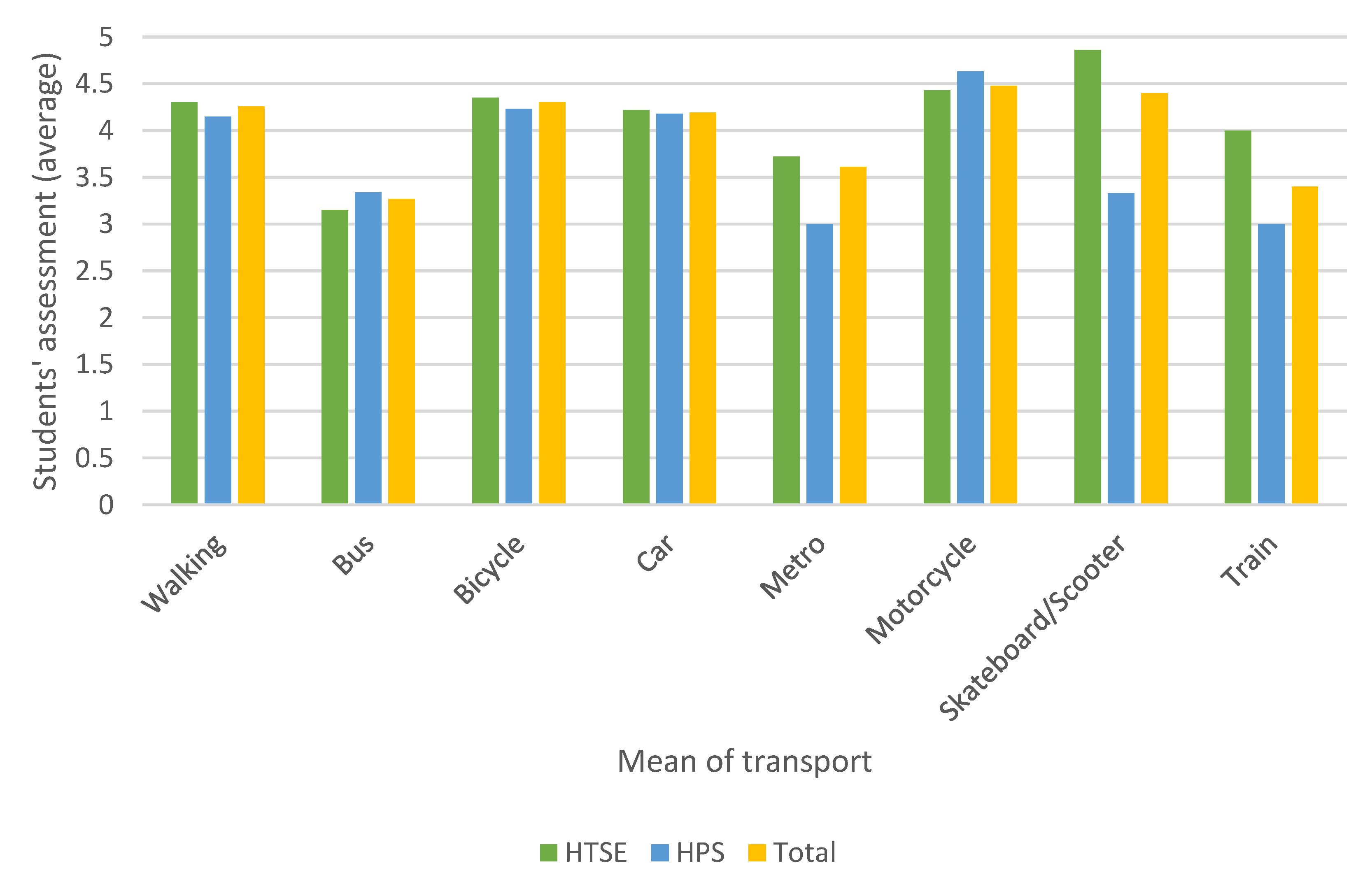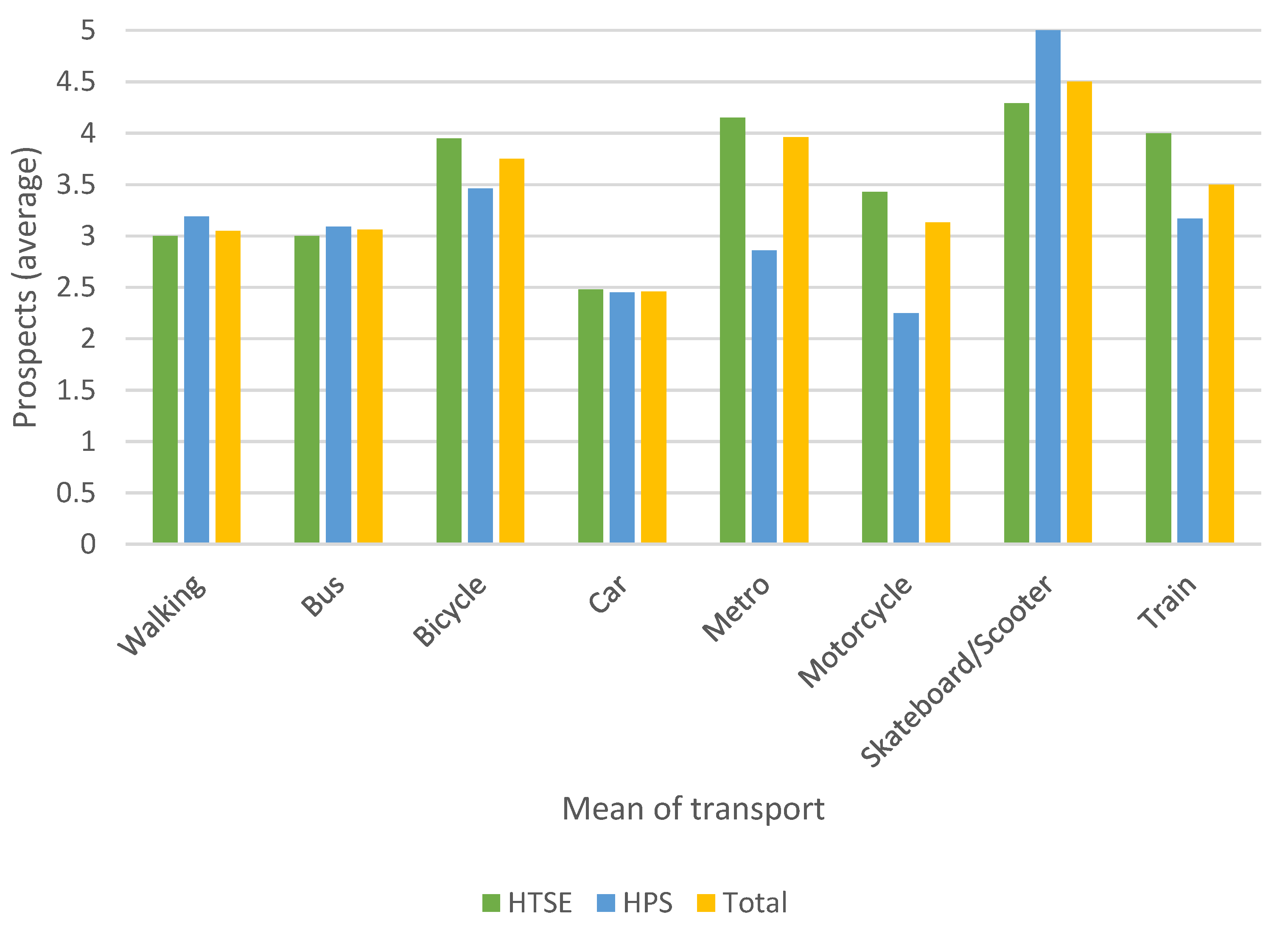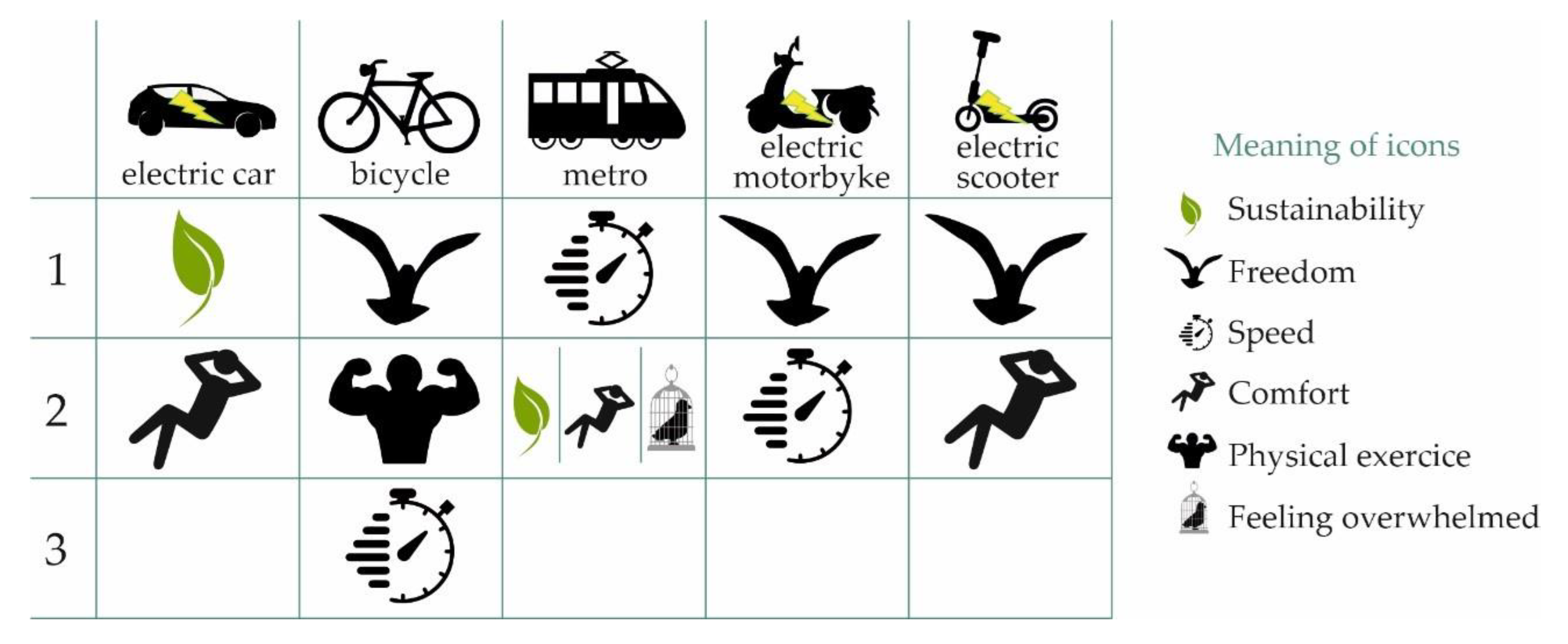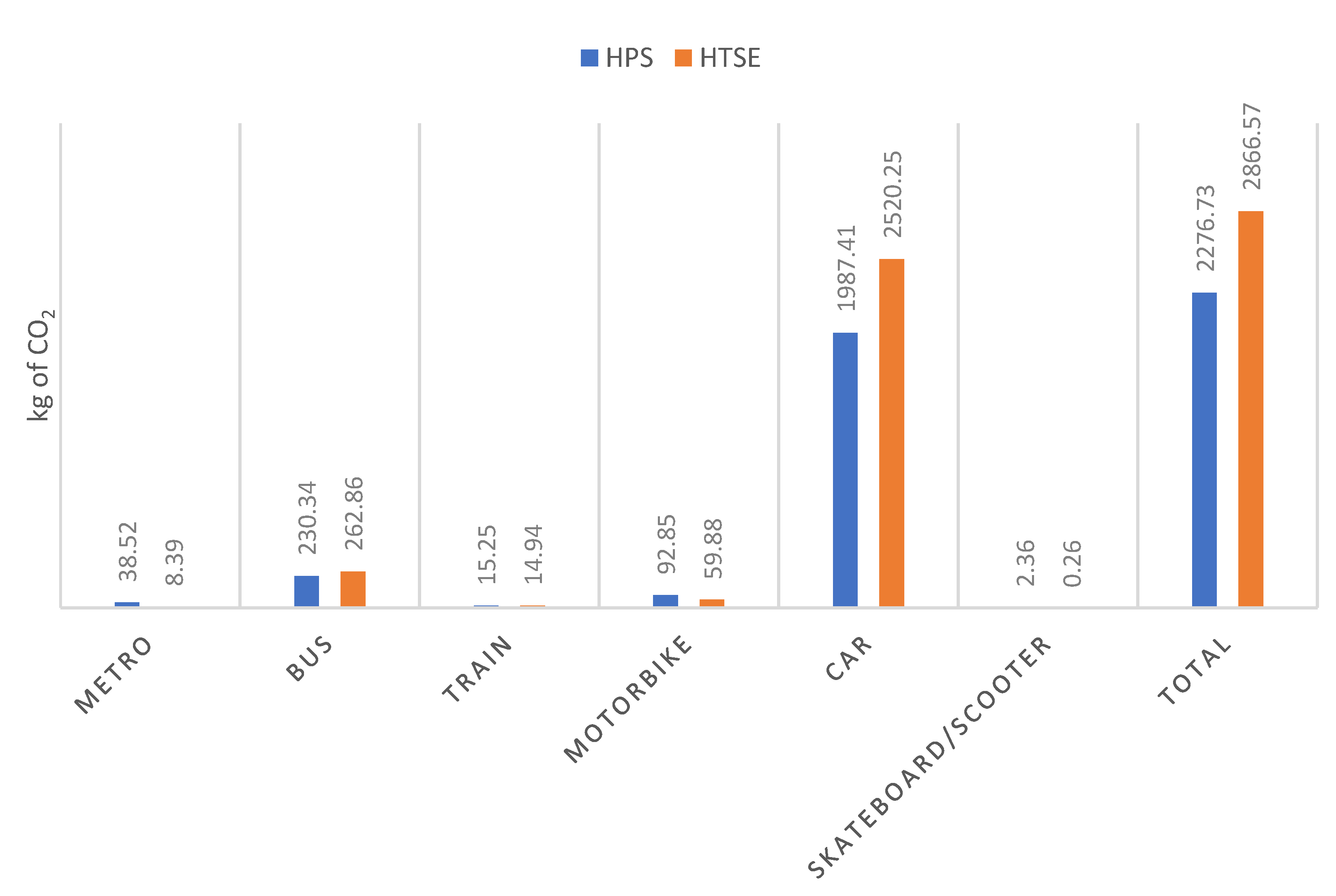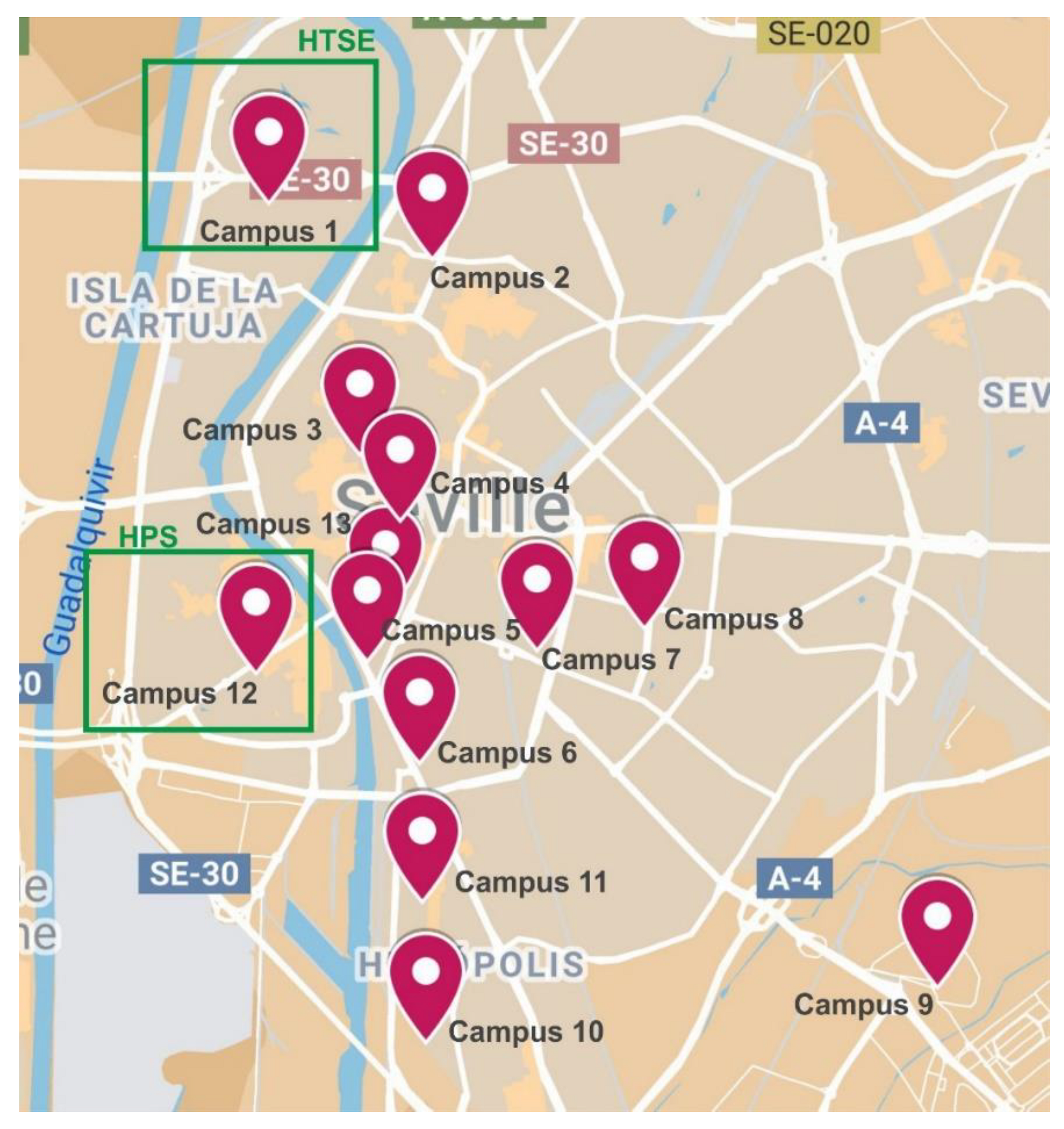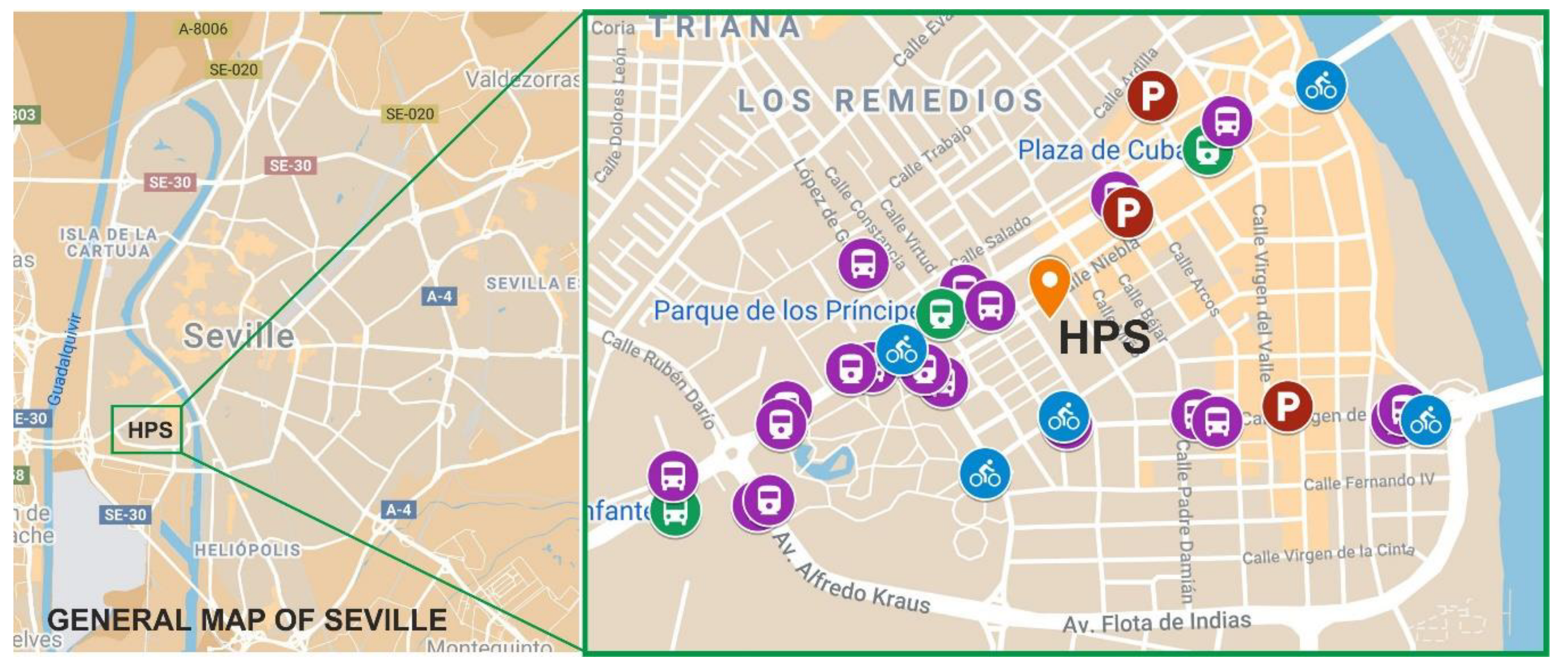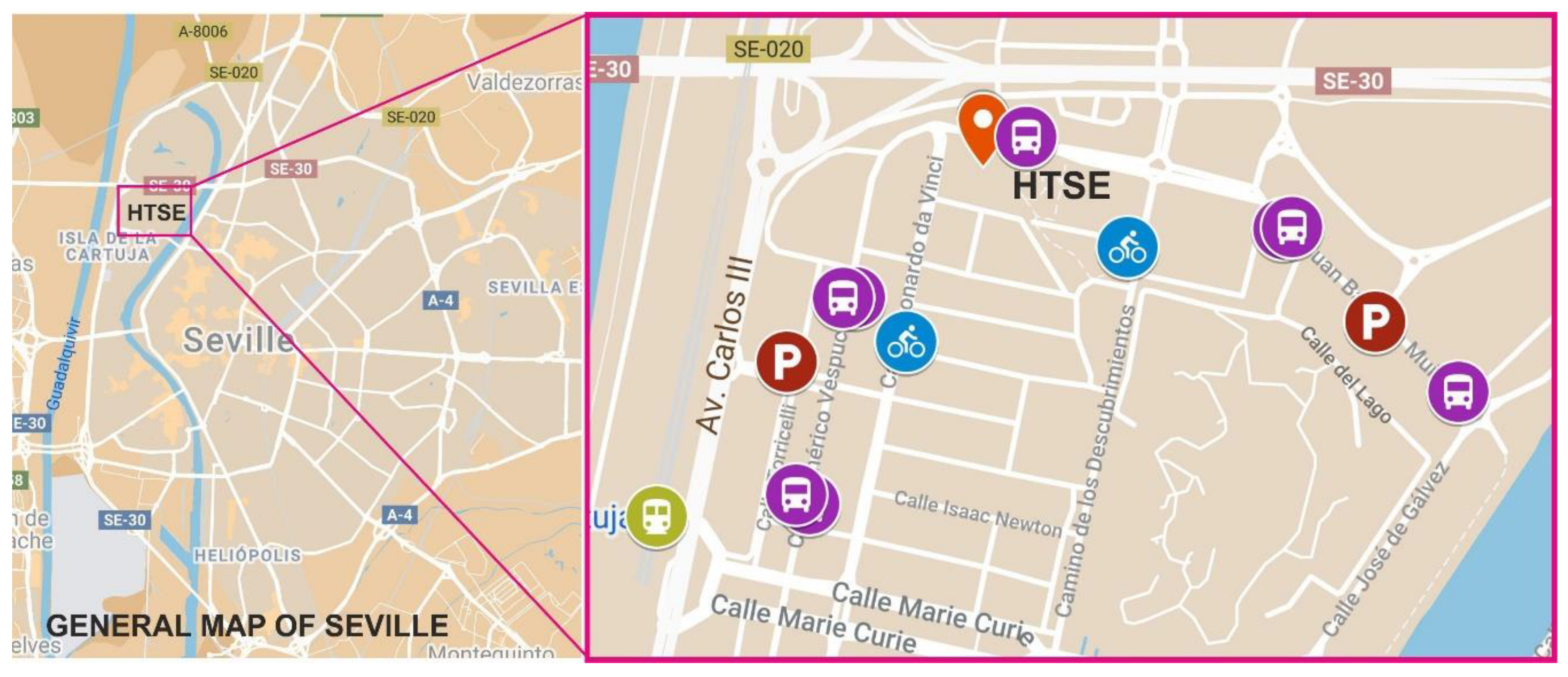1. Introduction
Mobility management in cities constitutes a major challenge [
1,
2]. There has been a rapid increase in city populations. In 2007, 50% of the world’s population lived in cities, and according to the United Nations’ Habitat program, it is estimated that by 2050, two-thirds of the world’s population will live in cities [
3].
The United Nations has proposed an agenda that seeks to promote sustainable human development, the well-known Sustainable Development Goals (SDGs) [
4]. The SDGs were approved in the year 2015 by the General Assembly of the United Nations [
4] and represent a first-level challenge for all countries. To achieve these goals, the participation of all actors is required, including governments, civil society, enterprises, and non-governmental organisations [
4,
5,
6]. The 2030 Agenda must be understood in a joint way, since the SDGs are interconnected with each other [
7,
8,
9].
Institutions of higher education play a fundamental role in achieving these SDGs [
7,
8,
10,
11,
12,
13]. In the exercise of teaching, research, and the transfer of results to society and governance, the university can provide a catalyst for social change [
10,
14,
15]. Despite this importance, sustainability on university campuses still has plenty of room for improvement [
16].
In previous work, we reflected on how the university can contribute towards the fulfilment of the Sustainable Development Goals through teaching [
8,
9] or research [
17]. In this case, we want to reflect on how the university can contribute to sustainable development with campus operations. We are interested in ascertaining the means of transport used by students in their transportation to the university, the reasons for their choice, and the prospects for change in the future. Engineering is an area of special interest for the achievement of sustainable development in general [
1,
18,
19,
20] and the Sustainable Development Goals in particular [
20,
21,
22], and for this reason, engineering students are those analysed in this study.
Previous work has reflected on the importance of using sustainable means of transport by the university community. In this respect, Mateo-Babiano et al. (2020) analysed the use that Filipino university students made of a system of shared bicycles [
18], and Cattaneo et al. (2018) analysed the attitudes of university students towards various sustainable modes of transport [
23]. In their work, the researchers revealed that the particularities of university campuses condition the type of student mobility. The use of transport in a Qatar University was carried out as a previous step for a sustainable mobility plan [
1]. That work showed that a high number of members of the university community came to the university in their own cars and showed the importance of infrastructure in promoting mobility of a more sustainable nature. The motivation for walking on campus was analysed in students from Malaysia [
24]. A study at a Greek university showed that a large majority of trips were made using public transport well in excess of those on foot or travelling in their own vehicles [
25]. The motivation for the use of sustainable means of transport in the European Union was studied by Heras Rosas and Herrera (2019) [
26].
Fissi et al. (2021) consider mobility as part of a strategy for the construction of green campuses [
27]. In this vein, they consider that the university can contribute towards sustainability from four fundamental facets: teaching, research, promotion of sustainability among members of the university community (engagement), and campus operations. It is precisely in this last dimension where they consider mobility through the promotion of cheaper and sustainable means of transport [
13,
27] (
Figure 1). The promotion of more sustainable modes of transport has effects on the environment, on the economy, and on the health of users [
28].
In previous work, the analysis of the life cycle of universities has been carried out [
19,
29]. Universities are very complex entities, and there are numerous factors that must be considered when evaluating the environmental impact of their activity [
19]. In this respect, transport and mobility are considered in the majority of the studies carried out regarding the analysis of the life cycle of the university [
19].
Several articles include recommendations for policymakers. Azzaly and Abdel Sabour [
1] propose a framework for the improvement of transport at Qatar University. Based on an analysis of transportation needs, they propose a mobility plan for the university that includes actions in infrastructure, transportation, and culture [
1]. The evaluation of the current situation and the knowledge of the opinions of the users of the means of transport are fundamental for the definition of public policies that promote sustainable mobility [
23].
In Spain, the sustainability commission, created within the Conference of Rectors of Spanish Universities, is responsible for evaluating environmental policies of Spanish universities and for promoting actions to reduce the environmental impact created by universities [
30]. It has several working groups: Evaluation of University Sustainability, Environmental Improvements in University Buildings, Sustainable Mobility, and University Urbanism [
30]. Ascertaining the opinions of students becomes crucial when promoting policies to promote sustainability on university campuses [
15].
The University of Seville (Spain) is an institution founded in 1505 and hosts 70,900 undergraduate, graduate, and doctoral students in its 32 owned and affiliated centres [
31].
The University of Seville has 13 campuses distributed throughout different areas of the city. It is made up of 56 buildings, including faculties, libraries, administration services, sports facilities, and general services.
The areas in which the 13 campuses are located are all accessible by urban transport (
Figure 2). Several of these campuses are located in the city centre and therefore enjoy better connections with public transport (train, metro, bus, bicycles, etc.). However, they also suffer from many more restrictions on car use due to the reduction in parking opportunities and to policies aimed at reducing the number of cars and at promoting pedestrianisation in downtown areas of the city. In contrast, those campuses located in the areas outside the city centre have a good public transport structure as well as an increase in the possibility of access to public parking. This situation also favours the use of private cars due to the decrease in services and transport combinations available.
The case that concerns us involves campuses 1 and 12 that together represent the university areas covering the field of engineering. The centres that will be analysed in this paper are the Higher Technical School of Engineering (HTSE) (Campus 1) and the Higher Polytechnic School (HPS) (Campus 12).
All areas of the city, and therefore all its campuses, are easily accessible through public transport throughout the week, since the city grants extended hours for the use of all of these means of transport. However, regarding the use of cars, from Monday to Saturday, there are paid outdoor parking areas throughout the city that make it difficult to park cars that do not belong to the residential area, especially in downtown areas and neighbouring annexes. The Higher Polytechnic School (HPS) campus is located in a neighbourhood attached to the downtown area of the city, and although it has high accessibility for all means of public transport, vehicle parking remains very limited owing to the overcrowding of residential vehicles. For the Higher Technical School of Engineering (HTSE) campus, the opposite is true; it is not located in a central or adjacent area and contains no residential buildings, and hence parking is free and more abundant. This situation causes the most commonly used means of transport for this campus to be the private vehicle.
The Higher Polytechnic School will soon be moved to the Scientific and Technological Park “Isla de la Cartuja” (Campus 1) in new facilities.
The objectives of this work are:
The structure of the article is as follows: in the next section, the methodology is described. For this purpose, the questionnaire employed, the sample analysed, and the statistical methods applied are all detailed. In
Section 3, the results are presented: firstly, the mobility patterns of the two schools analysed are described and the reasons expressed by the students for their choice of the means of transport and the evaluation of these are then analysed. The alternative means of transport are subsequently analysed, as are the CO
2 emissions emitted by each of the groups. In
Section 4, the results are discussed in comparison with other findings in the literature. Finally, the conclusions of the work are presented together with recommendations for policymakers, and the possible influence of COVID-19 is described.
4. Discussion
The results shown in this work are in line with the Mobility Plan of the city of Seville [
50]. According to this document, 8.8% of journeys in Seville are due to study trips, of which most are made on public transport (43.4%), 24.1% of the trips are in a private vehicle, 21.6% are made on foot, 7.7% are made by bicycle, and 3.2% are made by other means. Regarding the districts in which this work is framed, the Seville Mobility Plan [
50] establishes that most journeys to and from “La Cartuja” (HTSE) are made by car or motorcycle (54.2%), by bus (18.8%), and by bicycle (11.9%). In the case of journeys made to or from “Los Remedios” (HPS), 35.5% of the trips are made by ICE vehicle, 31.5% are made on foot, and 22% are made by bus. The results obtained in our study probably vary due to the lower purchasing power of students compared to that of other user profiles, such as professionals.
In the following figures (
Figure 11 and
Figure 12), an analysis of both campuses and their associated transportation structures is laid out in order to clarify the situation of both campuses.
Figure 11 shows the campus to which HPS belongs. It is in the “Los Remedios” neighbourhood, attached to the city centre, which is a highly residential area. The buildings have an average of four to five floors and, according to the 2019 city census, it houses a population of 25,038 inhabitants. For this reason, this area enjoys many services and an extensive public transport infrastructure, but it also has a limitation in the number of parking spaces for vehicles, since those that exist are largely paid. Within the public transport network, there are 3 metro stations, approximately 15 bus stops with approximately 12 bus lines that connect with various parts of the city, 5 municipal bicycle rental stations within a radius of 1 km of the HPS, numerous rental motorcycle parking areas, 1 paid parking esplanade at a reduced price attached to the metro station that connects to the outskirts of Seville, and 3 paid car parks.
Figure 12 shows the location of the campus where the HTSE is located. As indicated, this campus is in a neighbourhood far from the central areas of the city, where the universal exhibition was held in Seville in 1992. Since 1993, it has become a business area, far from the residential areas of the city and lacking services. It is connected through public transport (bus, suburban train whose station is 1 km away, and bicycle rental network), although it has no metro station (the closest station is 4.5 km away). There are a dozen bus stops where the two main circular lines of the city connect, two bicycle rental stations, two paid parking lots, extensive free parking throughout the urbanised areas of the neighbourhood, and a train stop connecting to the outskirts that connects with other areas of the city and neighbouring towns. As it is not a residential area, it has a greater area of parking for vehicles, although this unleashes a situation of isolation, since it is too far to arrive on foot and requires the use of transport, thereby increasing the use of private vehicles.
The city’s urban transport network is committed to reducing pollution and the use of renewable energy. The metro network is supplied by 100% renewable sources. Likewise, since the introduction in the city of its single operational metro line, it has progressed from 20.3 to 13.9 gigawatts/hour of consumption. By analysing the data of the last seven years, the average consumption per user has decreased from 1.44 to 0.80 kilowatt hours (kwh).
As for the bus network, it has a fleet of Compressed Natural Gas buses. The use of natural gas in urban transport provides considerable environmental benefits compared to the use of traditional fossil fuels, which highlights the zero emission of solid particles and SO2, as well as the significant reduction of NOx and CO emissions; a reduction is also achieved in CO2 emissions. With this reduction in emissions, the quality of the city’s environment has improved. Since the project began in 2006, the number of buses with this propulsion system has increased from 36 units (10% of the fleet) in 2006 to 275 units today (67% of the fleet).
Likewise, in the last 4 years, a network of electric rental motorcycles has been established in the city that, with more than a thousand motorcycles divided into several companies that currently have headquarters in Seville, offers citizens a simple, fast, and sustainable way of moving around the city.
From the literature review carried out, the link between the results obtained herein and previous research is sought. In this work, the differences due to location have been appreciated and, in addition, the hypothesis that the type of mobility varies according to the location of the university centre is verified. This is consistent with previous studies published in the literature [
23].
In a study conducted at Qatar University [
1], 69% of female students came to campus by car, 9% came by taxi, 1% came by carpool, and 21% came by other means of transportation (largely by bus). In the case of male students, 86% of the students had their own car, 8% caught a taxi, 6% travelled in a car with friends, and these male students did not report using public transport. A study carried out at the University of Bergamo [
23] found that 77% of students used sustainable means of transport, including active modes of transport (4%), carpooling, and using public transport. The remaining students used cars or motorcycles. In this same study, the authors found differences between the various university campuses [
23]. In the districts that were farthest from the city, students preferred to use private means of transport in comparison with the campuses located near the city centre or the historical centre, whose students preferred to use public means of transport [
23]. Similar differences between campuses have also been found in our study. In a study with UCLA students (USA), 32.7% of the students went to campus by car or motorcycle only, 30.9% used public transportation, 8.5% travelled by carpool, and 24.8% of the students went to their study centre on foot or by bicycle [
28].
In reference to the motivation shown by the students for the choice of various means of transport, a study by the University of Bergamo showed that students gave greater importance to comfort followed by sustainability and safety [
23]. Ramakreshnan et al. (2020) studied the motivation of the university community at a tropical university in Kuala Lumpur, Malaysia, for walking on campus [
24]. The reasons stated included the proximity of the buildings (90.7%), as exercise (88.7%), for transport (72.8%), and as recreation (55.6%) [
24].
Universities have a certain ethical commitment to society and can contribute through their way of promoting the construction of a more sustainable society [
13,
14,
15,
19]. Universities train the professionals and citizens of the future: in their classrooms, policymakers are formed [
27,
51,
52]. In this respect, it is crucial that universities address sustainability.
There are multiple possibilities for the development of the SDGs in the university context [
13]: the implementation of transformative actions can provide a good opportunity to contribute towards the construction of a more sustainable society [
27]. One of the main problems in the implementation of the Sustainable Development Goals is their multidisciplinary nature. In order to achieve these goals, it is necessary for the various actors to work together [
11]. Universities can contribute towards sustainability in a double direction, on the one hand by reducing the negative impacts they produce, and on the other hand by promoting improvement actions that make it possible to build a more sustainable world [
27].
Mobility carries a very important weight in the study of university life cycle analysis [
19]. In a study of the ecological footprint of the University Campus of Politecnico di Torino (Italy), it was determined that 52.7% of the carbon footprint was due to mobility [
53]. Other studies have corroborated the importance of mobility in the analysis of the life cycle of universities as in the Polytechnic University of Valencia [
54] and the University of Leon (Vegazana Campus) [
55].
It has been studied how the users themselves see their means of transport in the future.
On the one hand, the vehicles that the respondents themselves consider will be used more in the future (with respect to the means of transport they currently use) are the scooter (both electric and conventional), the metro, and the bicycle. On the other hand, those that will be used the least are the ICE car, the bus, and walking.
The electric scooter has undoubtedly been one of the revolutions of the 2019–2020 academic year (first lockdown in Spain), which has changed the current panorama in cities to the point of legislation having to be created for its control [
56]. This type of mobility is still growing in popularity in Seville since it is a flat city, the weather is good throughout the year, and there is already a good cycling network, which is where these users are usually observed. For these reasons, the bicycle will continue to perform better in the future according to the respondents. The university in Seville considers that the metro will be the best transport in the future after the scooter, any many wish that the metro lines would reach the HTSE so that cars and buses could be done without.
As for those that will be used the least, the university in Seville is aware that the ICE car is something of the past, and they do not expect this type of vehicle to continue in use in the future. The same happens with travelling on foot, since it is considered not very comfortable and very slow, and there are already options on the market, such as the bicycle and the electric scooter, that are not only more comfortable and faster but are also low-polluting vehicles. Finally, the bus is a somewhat outdated vehicle according to the opinion of the students, because it is a community, public, and slow means of transport, and it is not popular among student users.
Today, society is embroiled in a global problem, the coronavirus pandemic, which has direct implications regarding daily transportation. Nowadays, people generally create overprotective measures to prevent themselves from becoming infected with the virus, and hence solo transport and private vehicles have increased in number while normal and public means of transport have decreased [
57].
Furthermore, in public vehicles, such as the bus or the metro, the mandatory use of masks and a safe distance should be maintained at all times, which leads to fewer people allowed on buses. However, if before the pandemic the buses were full at peak times to the point that it would be necessary to increase the fleet, it will now be necessary to calculate whether this fleet should be increased, since fewer people fit on the bus, while at the same time, there are fewer people travelling by public transport. This in turn will affect the emission factor of buses during the pandemic, since there will be fewer people inside them, and therefore more pollutant load will be distributed per person.
Another type of mobility that is more in demand every year is that of vehicle-sharing systems: public bicycles, rental electric scooters, and rental electric motorbikes. However, it is a difficult period for these types of companies due to the fact that people have become more distrustful of car-sharing systems.
The current paradigm is undergoing a changing process; no one knows with certainty what will happen with the type of mobility that we are going to have, but it is believed that the trend towards sustainability will continue to grow.
In order to study the type of student mobility, one major requirement involves ascertaining whether university students consider sustainability to be relevant regarding their transportation.
When answering whether they could change to a more sustainable means of transport, the majority (44.34%) without any doubt answered yes, another large part (27.30%) had doubts and answered that perhaps they would, and another large part (28.35%) stated that they would not change.
In this work, we have studied the feelings that these means of transport transmit to the university students surveyed. The electric car conveys sustainability and comfort; the bicycle, on the other hand, conveys freedom and sportsmanship; the metro triggers feelings of speed, sustainability, comfort, and boredom; the electric motorcycle signifies freedom and speed; and the scooter conveys freedom and comfort.
In order to analyse the user, an initial study of age, gender, and the most frequent degrees and masters, among others, has been carried out. Various classes of user are distinguished by carrying out a user test, thereby obtaining clusters or groups of users. Seven user profiles have been obtained from a cluster analysis, and profiles have been generated according to the data obtained.
Regarding the results of the ecological footprint caused by the university student, two relevant results are extracted.
First, the mode or means of transportation used by the engineering student is discussed. More than one in four students decide to travel by private car to make the journey, while more than one in four students choose to catch the bus. These two are the most commonly used means of transport, respectively. On the other hand, combining walking with cycling also accounts for just over a quarter of the total, and it even exceeds the proportion travelling by bus.
Second, the results obtained after their analysis are examined. As expected, more kg of CO2 are emitted per week per person in the HTSE than in the HPS: 10.54 compared to 8.36. In addition, the HTSE has more students than the HPS, and hence, in terms of final emissions, it is normal for them to be higher than 1896.91 tons compared to 702.44.
Currently, the two centres together emit 2600 tons of CO
2, which is a major figure to take into account, since only students and their transport are being counted. In comparison with other Spanish universities, the tons emitted are similar; it can be compared, for example, with the Campus Vegazana of the University of León, which, in 2006, polluted 1425.26 tons of CO
2 through cars [
55], with around 10,000 students. Approximately, the HTSE and the HPS account for 30% of the total by car, which would be 780 tons of CO
2. In addition, knowing that the total number of students is 8800, it can be seen that it is a somewhat lower figure than that of the Vegazana Campus, so it can be said that the result is optimal.
On the other hand, if the university is observed in its entirety, in 2007, the University of Santiago de Compostela emitted 5749.80 tons of CO
2 [
10] with 30,200 students, and in 2011, the University of Valencia emitted 32,562.10 tons of CO
2 with more than 60,000 people [
58].
As can be observed, the transfer of the Higher Polytechnic School will incur 25.9% more impact on CO2 when comparing the two locations, since it will increase from 702.44 tons of CO2/year to 885.22. This is what will be assumed in the transfer of the location of the polytechnic from its present location in Los Remedios to the new premises in Cartuja. However, as there are fewer students than in the Higher Technical School of Engineers, it remains less polluted than the latter.
In our case, most of the CO2 emissions are due to the use of the ICE car, which is why we should encourage the use of less polluting vehicles and mainly means of transport with zero real emissions (bicycle and walking). Although the electric vehicle does not directly emit CO2, the CO2 needed to produce the electricity it consumes should be taken into consideration.
There are some experiences of promoting sustainable transport in universities in the context of the process of transformation towards the so-called green campuses [
27,
59]. In this respect, the University of Florence provided students with a card for public transport at a reduced price [
27]. This same university joined national and international networks for the promotion of sustainable mobility [
27] such as the European Network for Sustainable Mobility at Universities [
60]. This network is the result of a project co-financed by the European Union that is being developed in the 2016–2021 timeframe and seeks to promote sustainable modes of transport in the context of European universities [
60].
In the case of Qatar university, Azzali and Abdel Sabour (2018) provide several proposals for the improvement of mobility: improve bus lines for students, create bus lines for staff living in the same compound, promote transportation of a more sustainable nature among the university community, increase teleworking, and create public transportation infrastructure, such as metros and railroads [
1]. Chulalongkorn University proposed several actions that include the creation of a parking system that reduces the use of the car within the campus, by promoting collective means of transport, the electric vehicle, and also the bicycle and travelling on foot [
2]. Previous work has found barriers to the use of sustainable means of transport such as bicycles, including perceived safety, the need for helmets, low awareness, and physical fitness [
18].
The reasons most often given in student responses for making a change in modes of transportation are speed, sustainability, and economics. Therefore, means of transport that include these three characteristics should be encouraged. Given the circumstances brought about by the current COVID-19 pandemic, light vehicles, such as bicycles and scooters, should probably be considered.
5. Conclusions
Universities play a crucial role in promoting sustainability and achieving SDGs. Higher education institutions can contribute towards these objectives through all their functions (teaching, research, transfer) and even through their operation, thereby contributing to the construction of a better society.
The interurban mobility of engineering students from two centres of the University of Seville has been studied. Students from each of the study centres use various means of transportation. Three constructs could be found to describe the motivation for choosing the means of transport. The first of these includes factors such as speed, ease of access, freedom, and comfort. The second is related to sustainability and the price of the means of transport. The last of these factors is safety.
In general, students are satisfied with the most frequently used means of transportation. Users give lower marks to collective means of transport (train, bus, and metro).
Students who use transportation of a more polluting character show a desire to switch to another means of transportation. A greater fidelity to the chosen means of transport was found among the students who use low-emission means of transport. The most frequently chosen alternative means of transportation was the electric car followed by the bicycle. Based on the students’ answers, seven student profiles have been found through the application of clustering. These groups of students would allow the design of specific actions according to each of the profiles.
Regarding CO2 emissions, the average values of the two university centres differ. Most of the emissions are due to the use of ICE cars. This shows a direction in which to work towards reducing emissions in urban mobility among these students.
The conclusions of this study cover both the emotions that the modes and means of transport produce in engineering students and the calculation of CO2 emissions that they produce due to their displacement.
Specifically, the conclusions are established in four areas:
Each mode or means of transport conveys a different emotion.
There is a difference in the type of mobility depending on the location of the university centre.
The transfer of the HPS to Cartuja will incur an increase in CO2 emissions.
Despite the differences between the centres and their mobility style, both HPS and HTSE students measure each emotion in a similar way, except regarding sustainability and economy.
The university student considers it crucial that the ideal mode or means of transport should be a fast and comfortable vehicle, which grants a feeling of freedom, that is, one that feels free at the time of use and that removes any type of burden such as that caused by heavy traffic or the lack of convenient parking spaces. Furthermore, it must also be a sustainable and economical mode or means of transport.
In general terms, no priority is placed on the safety or quietness of the vehicle, nor is autonomy a requirement, as long as the means is sufficient to travel from home to school and vice versa.
The best-valued modes and means of transport are light, among which are both the bicycle and the scooter.
The three ideal vehicles for engineering university students are the bicycle, the scooter, and the motorcycle, since they are economical vehicles, fast in the city, comfortable both when moving around and avoiding traffic jams and when parking quickly; they offer a feeling of freedom, and they are relatively sustainable (the bicycle being more sustainable than the motorcycle). However, for students who feel that they need a safer vehicle, they are likely to choose other means, such as the car or walking. In addition, there are students who live far from the school and travel by public transport or by car, but they take it as the only option, not as the one that best meets their needs.
Possible future work is proposed both in the field of sustainability and for Industrial Design and Product Development.
In the line of sustainability, it is proposed to continue this line of reasoning and find the ecological footprint of the University of Seville. The electric scooter and the subway are the means of transport that the students consider that they will be more used in the future. This is the reason why a comparative study has been carried out between these two means of transport using Kansei Engineering. On the other hand, more than one-third of those surveyed use the car individually, which is the most polluting means of transport. The possibility of modeling an interuniversity Carsharing APP or web page is proposed to help reduce emissions. Finally, a line that is closer to marketing could involve the creation of a communication strategy to make university youth aware of the importance of using transport of a more sustainable nature.
Based on the results obtained, the recommendations for policymakers and a reflection on the impact of COVID-19 on university mobility are set out below.
5.1. Recommendations for Policymakers
Considering the results of the work, the following recommendations could be proposed to policymakers.
Institutions of higher education should be evaluated using instruments that go beyond their research activity [
10]. The activity of universities is oriented towards the position and impact on the rankings [
61]. In this respect, it is fundamental that parameters of sustainability and compliance with the SDGs begin to appear in these rankings [
7,
61], and they should be considered for the financing of the universities [
16]. The creation of rankings that evaluate the role of higher education institutions in achieving the SDGs, such as “The Impact Ranking” [
62], is an opportunity for higher education institutions [
7]. In the second edition of this ranking, 768 universities from 85 countries were evaluated, and the results were measured in three areas: research, outreach, and stewardship [
62].
The role of sustainability offices or green offices needs to be strengthened to promote change in universities [
14,
63]. Recent work has pointed out the lack of funds, the lack of support from the administration [
63], and the lack of interest from students and staff as possible barriers for these institutions. In this respect, the incorporation of green offices that are led by students will promote the construction of a more sustainable university. In this way, the role of students remains highly significant, and their opinions must be taken into account as a starting point for future policies and investments in the university [
18].
In order to promote sustainable means of transport, it is essential to create an ecosystem that makes transport comfortable, fast, and safe. In this respect, initiatives such as bike sharing [
2,
59] and a cycle path system can contribute towards the promotion of these means of transport among university students. It is also interesting to promote these means of transport through the use of subsidies and the improvement of collective means of transport [
27,
28].
5.2. Universities in the Post-COVID Era
The surveys were applied before the first pandemic lockdown. One of the future lines of work will be to study the variation in student opinion due to the presence of a disease, such as COVID-19, which is transforming the way classes are taught [
64,
65,
66] and altering mobility patterns in our cities [
67].
In post-pandemic conditions, the perception of public transportation as unhealthy can gain ground and remain. It is necessary to restore the capacity of public transport systems to fulfill their social role [
68].
Before the pandemic, transport policy was focused on demand management, “smart” technology interventions, and sustainable mobility. The situation resulting from the pandemic presents an opportunity to reconfigure future transportation policies and practices, with an environmental perspective, both from a global point of view and by individual citizens. This public health crisis has required a new vision of transportation and its role in economic recovery [
69].
Many cities have chosen to promote collective transport to reduce pollution [
2,
59]. However, the existence of an illness that requires an increase in social distancing can make these means of transport more unsafe. In this regard, it is necessary to take extreme measures to make public transport a safe place, one that allows social distancing to be maintained, in order not to harm its users [
57]. The results presented in this work should be contrasted with future research regarding the opinions of users who are aware of the risk of the disease.
University education in the aftermath of the COVID-19 pandemic will need to be even more focused on the development of student skills towards active learning [
64]. In the current context, there is a trend towards the digitalisation of universities and teleworking [
65,
66]. Obviously, these circumstances will exert a positive effect on mobility, and therefore, in turn, its effect on the ecological footprint of the university should be studied. Azzali and Abdel Sabour proposed telecommuting as a tool to improve the mobility of the University of Qatar in 2018 [
1].
Although the work was developed prior to the pandemic containment, it provides a baseline for measuring future changes in student mobility behaviour.

